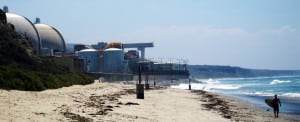
By Thomas Gardiner
A settlement announced Monday could provide a path for more than 3.5 million pounds of nuclear waste from storage at the San Onofre Nuclear Generating Station (SONGS) along a California fault line to a more stable facility inland.
The settlement agreement filed with the state Superior Court in San Diego brought potential resolution to a lawsuit filed by advocacy organization Citizens’ Oversight and local resident Patricia Borchmann against the California Coastal Commission, which approved an expansion of SONGS’ on-site spent fuel storage facility to enable it to hold material now in wet storage.
Potential sites for the nuclear waste transfer include the Palo Verde nuclear plant in Arizona, of which SONGS majority owner Southern California Edison is part owner, as well as planned consolidated interim sites for spent reactor fuel in New Mexico or Texas.
“The agreement plots a prudent strategy in furtherance of the goal of moving the fuel sooner than later,” Ray Lutz, founder of Citizens’ Oversight, told RadWaste Monitor.
Like all used fuel from U.S. commercial nuclear reactors, the waste from SONGS is under a 1987 act of Congress supposed to be interred at the geologic repository at Yucca Mountain in Nevada. But progress on the facility has been halting, with the Obama administration canceling Yucca Mountain and the Trump administration seeking to revive the project. In any case, the site is years away from realization, forcing the federal government and nuclear utilities to find interim means for managing nuclear waste.
After SONGS Units 2 and 3 were permanently shut down due to safety concerns in 2013, the California Coastal Commission in October 2015 approved a 20-year permit for SCE to expand its coast-side spent fuel dry storage pad to hold all of the facility’s nuclear waste. Roughly two-thirds of the used fuel from the two reactors is now in wet storage. With no federal repository for nuclear waste, the spent fuel seemed destined to sit at San Onofre, atop an active fault line and just hundreds of feet from the Pacific Ocean.
Citizens’ Oversight sued the commission in November 2015 to block the permit, and Southern California Edison stood as a party of interest to the case. But the sides earlier this year entered into settlement talks, and a deal was announced Monday.
The agreement calls for the lawsuit to be dismissed with prejudice – meaning it cannot be refiled – and authorizes Southern California Edison to move ahead with expanding the spent fuel storage pad at SONGS. In return, the utility offered a number of commitments, starting with pursuing “Commercially Reasonable” activities to move the spent fuel to an off-site location for storage. It will spend up to $4 million on a number of commitments toward this goal, including: establishing a panel of experts to provide guidance on spent fuel relocation, prepare plans for transport and off-site storage of SONGS’ spent fuel, and make an official offer to the Palo Verde plant’s ownership to expand its storage pad to hold the San Onofre spent fuel.
Within hours of the agreement, though, opposition to the transfer came from an SCE partner at a facility at the Palo Verde Nuclear Generating Station near Tonopah, Ariz. Facility operator Arizona Public Service Co. (APS) said it would not take waste shipments from San Onofre. APS owns about 29 percent of Palo Verde and Southern California Edison holds about 15 percent of its ownership.
“We safely and securely store Palo Verde’s used fuel. The bottom line is we are not licensed to store used fuel from any other facility. There is no initiative that makes sense to start the licensing process,” said APS spokeswoman Jill Hanks.
“I think it is improper for them to sell power while generating waste themselves without even talking to their co-owner Edison about moving the waste from San Onofre,” Lutz said.
According to Lutz, it made sense to keep the spent fuel waste at San Onofre when the reactors were running, even if the location of the plant itself was a poor choice. He said the criticality dangers associated with operational reactors already outweighed the dangers of the spent fuel. But since the reactors were taken permanently offline, he said there is no reason to keep the material there.
“This nuclear waste sits only 100 feet from the Pacific Ocean, and is right next to a major interstate and a rail line,” Lutz said. “It needs to be moved to protect the people. If it can’t go to Palo Verde, we will have to look at other options.”